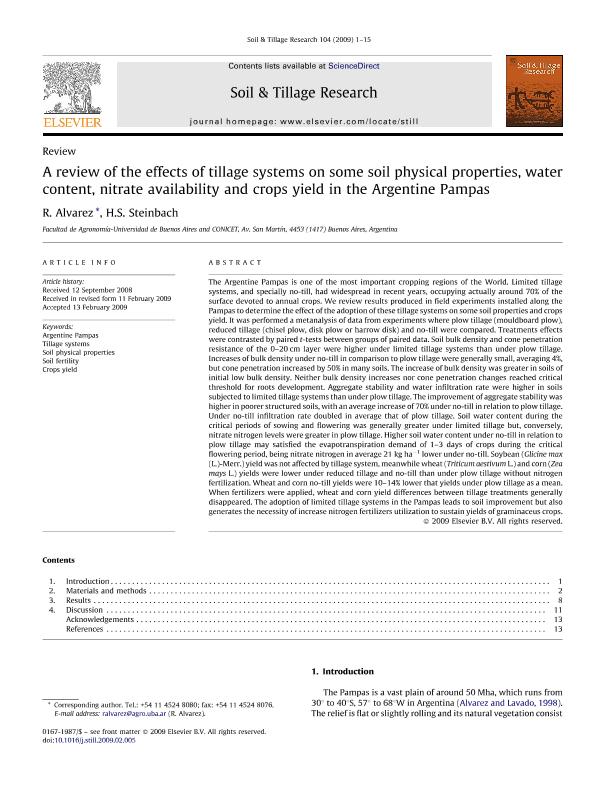Artículo
A review of the effects of tillage systems on some soil physical properties, water content, nitrate availability and crops yield in the Argentine Pampas
Fecha de publicación:
06/2009
Editorial:
Elsevier Science
Revista:
Soil & Tillage Research
ISSN:
0167-1987
Idioma:
Inglés
Tipo de recurso:
Artículo publicado
Clasificación temática:
Resumen
The Argentine Pampas is one of the most important cropping regions of the World. Limited tillage systems, and specially no-till, had widespread in recent years, occupying actually around 70% of the surface devoted to annual crops. We review results produced in field experiments installed along the Pampas to determine the effect of the adoption of these tillage systems on some soil properties and crops yield. It was performed a metanalysis of data from experiments where plow tillage (mouldboard plow), reduced tillage (chisel plow, disk plow or harrow disk) and no-till were compared. Treatments effects were contrasted by paired t-tests between groups of paired data. Soil bulk density and cone penetration resistance of the 0–20 cm layer were higher under limited tillage systems than under plow tillage. Increases of bulk density under no-till in comparison to plow tillage were generally small, averaging 4%, but cone penetration increased by 50% in many soils. The increase of bulk density was greater in soils of initial low bulk density. Neither bulk density increases nor cone penetration changes reached critical threshold for roots development. Aggregate stability and water infiltration rate were higher in soils subjected to limited tillage systems than under plow tillage. The improvement of aggregate stability was higher in poorer structured soils, with an average increase of 70% under no-till in relation to plow tillage. Under no-till infiltration rate doubled in average that of plow tillage. Soil water content during the critical periods of sowing and flowering was generally greater under limited tillage but, conversely, nitrate nitrogen levels were greater in plow tillage. Higher soil water content under no-till in relation to plow tillage may satisfied the evapotranspiration demand of 1–3 days of crops during the critical flowering period, being nitrate nitrogen in average 21 kg ha−1 lower under no-till. Soybean (Glicine max (L.)-Merr.) yield was not affected by tillage system, meanwhile wheat (Triticum aestivum L.) and corn (Zea mays L.) yields were lower under reduced tillage and no-till than under plow tillage without nitrogen fertilization. Wheat and corn no-till yields were 10–14% lower that yields under plow tillage as a mean. When fertilizers were applied, wheat and corn yield differences between tillage treatments generally disappeared. The adoption of limited tillage systems in the Pampas leads to soil improvement but also generates the necessity of increase nitrogen fertilizers utilization to sustain yields of graminaceus crops.
Palabras clave:
TILLAGE
,
PHYSICAL PROPERTIES
,
CROPS YIELD
Archivos asociados
Licencia
Identificadores
Colecciones
Articulos(OCA PQUE. CENTENARIO)
Articulos de OFICINA DE COORDINACION ADMINISTRATIVA PQUE. CENTENARIO
Articulos de OFICINA DE COORDINACION ADMINISTRATIVA PQUE. CENTENARIO
Citación
Alvarez, Roberto; Steinbach, Haydee Sara; A review of the effects of tillage systems on some soil physical properties, water content, nitrate availability and crops yield in the Argentine Pampas; Elsevier Science; Soil & Tillage Research; 104; 1; 6-2009; 1-15
Compartir
Altmétricas




